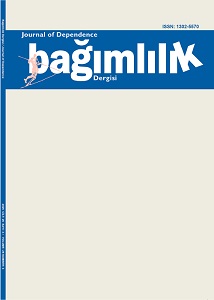PSYCHOACTİVE SUBSTANCE USE İN MALE PATİENTS HOSPİTALİZED İN AN ACUTE PSYCHOSİS CLİNİC AND ITS EFFECT ON CLİNİCAL VARİABLES
Keywords:
psychoactive substance, psychosis, affective disorderAbstract
Objective: Psychoactive substance use is common in psychotic patients and its prevalance was reported to be 3.2% in schizophrenia and 3.5% in bipolar disorder in Turkey. Substance use has been found to aggravate positive symptoms, increase the number of hospitalizations and relapses, and to be related with suicidal ideation, agression and noncompliance to treatment. In this study, it was aimed to determine the rate of subtance use in male patients hospitalized in an acute psychosis clinic, and investigate clinical and sociodemographic parameters which might be related with subtance use.
Method: Records of patients who were hospitalized between 01 March-31 May 2014 have been examined retrospectively. Sociodemographic and clinical data forms have been filled. Data of physical restraints have been obtained from physical restraint registry book.
Results: In this study, ongoing substance use was detected in 109 of 351 patients (31.1%). Substance use was found to be more common in affective disorders (21.8%) than psychotic disorders (14%). Substance users were younger (mean age 28.9±7.4) than patients who do not use any substance (37.5±12.2) (p<0.001). It was also found that 81.7% of substance users, but only 54.6% of patients who do not use any substance consisted of single patients (p<0.001). Substance users had shorter history of mental illness (5.67±5.8 years) than patients who do not use any substance (10.45±9.7 years) (p<0,001). In psychotic and affective patients who have alcohol or substance use, the number of hospitalizations (p=0.05, t=1.9) and the rate of physical restraint (36.7%) were higher (p=0,001).
Conclusion: Patients who have psychoactive substance use and their relatives should be informed and referred to alcohol-substance treatment clinics if necessary. In these patients effective treatment of substance use may affect the prognosis positively.
References
Gregg L, Barrowclough C, Haddock G. Reasons for increased substance use in psychosis. Clin Psychol Rev 2007; 27(4):494-510.
Barnes TRE, Mutsatsa SH, Hutton SB et al. Comorbid substance use and age at onset of schizophrenia. B J Psych 2006; 188:237-242.
Kerner B. Comorbid substance use disorders in schizophrenia: A latent class approach. Psychiatry Res 2015; 225(3):395-401
Goldberg JF, Garno JL, Leon AC, et al. A history of substance abuse complicates remission from acute mania in bipolar disorder. J Clin Psychiatry 1999; 60(11):733-740.
Güleç MY, Elbay RY, Şayakçı Ş ve ark. Yatan psikiyatri hastalarında madde kullanımı Bir Akut Psikoz Kliniğinde Yatan Erkek Hastalarda Psikoaktif Madde Kullanımı ve Klinik Değişkenler Üzerine Etkisi ve hastalıklara göre dağılımı: Retrospek-tif bir çalışma. Düşünen Adam Psikiyatri ve Nörolojik Bilimler Dergisi 2010; 23:166-173.
Kavanagh DJ, Waghorn G, Jenner L et al. Demographic and clinical correlates of comor-bid substance use disorders in psychosis: multivariate analysis from an epidemiological sample. Schizophr Res 2004; 66: 115-124.
Migon MN, Coutinho ES, Huf G et al. Factors associated with the use of physical restraints for agitated patients in psychiatric emergency rooms. Gen Hosp Psychiatry 2008; 30:263-268.
Evren C, Bozkurt M. Sentetik kannabinoidler: Son yılların krizi. Düşünen Adam The Journal of Psychiatry and Neurological Sciences 2013; 26:1-11
Kalyoncu ÖA, Ünlü B, Taştan U. Gençlerin tehlikeli oyunu: Sentetik kannabinoidler (Bonzai) üzerine bir gözden geçirme. Journal of Dependence 2014; 15(3):150-155
Fattore L, Fratta W. Beyond THC: The new generation of cannabinoid designer drugs. Front Behav Neurosci 2011; 5:60-66
Downloads
Published
How to Cite
Issue
Section
License
Copyright (c) 2025 Journal of Dependence

This work is licensed under a Creative Commons Attribution-NonCommercial-NoDerivatives 4.0 International License.
...
